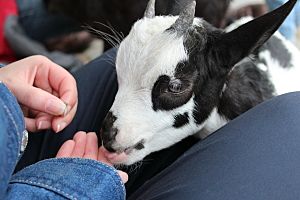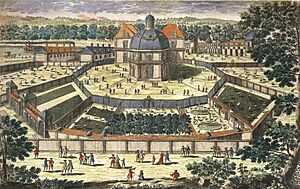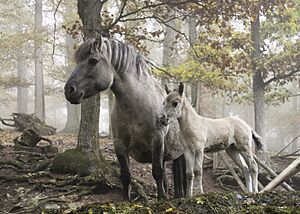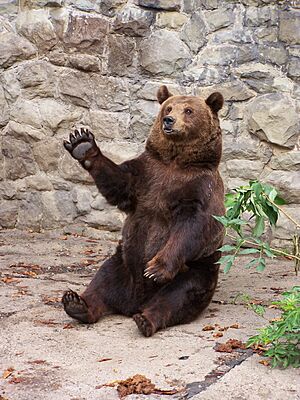Zoo facts for kids
A zoo is a special place where many different kinds of animals live so people can visit and learn about them.
Modern zoos are more than just places for fun. They also focus on education, research, and helping to protect animals. Many zoos work to save rare animals that are in danger of disappearing forever. These zoos try to give animals a life that feels natural, so they stay healthy and act like they would in the wild. This helps the animals and lets visitors see them in a more natural way.
Running a zoo costs a lot of money. Zoos teach people about the amazing variety of life on Earth. They help people and wildlife live together peacefully. They also do important research and offer learning programs. Zoos work hard to make sure the animals in their care have the most natural environment possible. Without enough money, they can't do these important things.
Sadly, some zoos are not like modern ones. Animals there might live in small spaces, feel unhappy, and get sick because their living conditions are not good.
Contents
History of Zoos
Early Animal Collections
Long ago, before modern zoos, there were places called menageries. These were private collections of animals, often owned by kings or emperors.
- The oldest known animal collection was found in Hierakonpolis, Egypt, around 3500 BCE. It had animals like hippos, elephants, and baboons.
- In ancient China, Empress Tanki had a "house of deer," and King Wen of Zhou had a huge zoo called the Garden of Intelligence.
- Famous rulers like King Solomon and Alexander the Great also collected animals. The Roman emperors kept animals for study or for shows in arenas.
- Charlemagne, a famous European emperor, even had an elephant named Abul-Abbas!
In England, King Henry I of England had a collection of lions and leopards. The most famous early collection in England was at the Tower of London, started by King John I in 1204. Later, it was opened to the public. People could pay to get in or even bring a cat or dog to feed the lions! These animals were later moved to the London Zoo.
In the Americas, the Aztec emperor Moctezuma had a huge "house of animals" in his capital city, Tenochtitlan. It had many birds, mammals, and reptiles, cared for by over 600 people. Sadly, this amazing collection was destroyed during a battle.
Zoos in the Enlightenment
The oldest zoo still open today is the Tiergarten Schönbrunn in Vienna, Austria. It was built in 1752 for Emperor Francis I as part of Schönbrunn Palace. At first, only the royal family could visit, but it opened to everyone in 1765.
Later, in 1795, the zoo in the Jardin des Plantes in Paris was started. Its animals came from the royal menagerie at Versailles. This zoo was mainly for scientific study and teaching people.
The Modern Zoo Begins
Before the 1800s, zoos often showed off a ruler's power. But in the 19th century, zoos in big European cities started to change. They became public places, not just for royalty. The new goal was to teach everyone about animals using modern science. These zoos were supported by local groups who wanted to promote science and learning.
Zoos in the British Empire
The modern zoo as we know it really began in the UK in the 1800s. These zoos focused on scientific study and later on educational displays for the public.
People were becoming very interested in natural history and zoology. As London grew, there was a greater need for public entertainment. This led to the creation of the first modern zoos.
The Zoological Society of London started the London Zoo in 1828. It was the world's first scientific zoo. Even though it was first meant for scientific study, it opened to the public in 1847. The London Zoo was built right in the middle of the city for everyone to enjoy, and its design was copied by many other city zoos. In 1853, it also opened the world's first public aquarium.
Other early zoos included Dublin Zoo (1831) and Downs' Zoological Gardens in Nova Scotia (1847). The first zoo in Australia was Melbourne Zoo in 1860.
Zoos in Germany
In Germany, important zoos opened in Berlin (1841), Frankfurt (1856), and Hamburg (1863). In 1907, a man named Carl Hagenbeck started the Tierpark Hagenbeck in Hamburg. His zoo was very different! It was the first to use open areas with moats instead of cages, making the animals' homes look more natural. He also put different types of animals together in exhibits and organized the zoo by where animals came from in the world.
Zoos in Poland

The Wrocław Zoo is the oldest zoo in Poland, opening in 1865. It has about 10,500 animals from 1,132 different species, making it one of the largest in the world by species count. In 2014, the Wrocław Zoo opened the Africarium, a special oceanarium that only features animals from Africa. It has over 10,000 animals, from insects to elephants.
Zoos in the United States
The Philadelphia Zoo opened on July 1, 1874, and is known as "America's First Zoo." The Lincoln Park Zoological Gardens in Chicago and the Cincinnati Zoo opened in 1875.
During the 1930s, government programs helped many local zoos with money. This support helped build, fix, and expand zoos when local budgets were very low.
By 2020, the United States had 230 accredited zoos and aquariums. They housed 800,000 animals from 6,000 species, including about 1,000 endangered ones. These zoos provide many jobs, spend a lot on wildlife conservation, and welcome over 200 million visitors each year. They also have special programs for schools.
Zoos in Japan
Japan's first modern zoo, Tokyo's Ueno Imperial Zoological Gardens, opened in 1882. It was based on the zoos in Europe.
Types of Zoos
Zoo animals live in special areas called enclosures. These enclosures often try to look like the animals' natural homes or how they behave in the wild. This is good for both the animals and the visitors.
- Nocturnal animals (animals active at night) often live in buildings with a reversed light cycle. This means dim lights are on during the day so visitors can see them, and brighter lights are on at night when the animals usually sleep.
- Zoos create special climates for animals from extreme places, like penguins.
- There are also special enclosures for birds, mammals, insects, reptiles, fish, and other water animals.
- Some zoos have "walk-through" exhibits where visitors can enter areas with friendly animals like lemurs or turtles. Visitors are asked to stay on paths and not feed the animals.
Safari Parks

Some zoos keep animals in very large, outdoor enclosures. Instead of cages, they use moats and fences to keep animals in. Safari parks (also called zoo parks) let visitors drive their cars through the animal areas, getting very close to the animals. Sometimes, you can even feed animals through your car window!
The first safari park was Whipsnade Park in England, opened in 1931. Today, it covers a huge area. Other famous safari parks include the San Diego Zoo Safari Park in California and the North Carolina Zoo.
Aquariums

A public aquarium is like a zoo for water animals. The first public aquarium opened at the London Zoo in 1853. After that, many more aquariums opened in Europe and the United States.
Petting Zoos

A petting zoo (or petting farm) has a mix of farm animals and wild animals that are calm enough for people to touch and feed. To keep the animals healthy, the zoo provides the food for visitors to give them.
Animal Theme Parks
An animal theme park mixes an amusement park with a zoo. These parks are mostly for fun and entertainment. Places like Sea World are large dolphinariums that keep whales and have other shows and rides. Other animal theme parks have more entertainment, like stage shows, roller coasters, and even mythical creatures. Examples include Busch Gardens Tampa Bay and Disney's Animal Kingdom.
Images for kids
-
Penguins at London Zoo.
-
Giant Pandas in Chiang Mai Zoo.
-
A Siberian tiger (Panthera tigris altaica) at Korkeasaari Zoo in Helsinki, Finland
-
London Zoo, 1835
-
Ota Benga, a human exhibit in New York, 1906
-
The African plains exhibit at North Carolina Zoo shows how big an open-range zoo can be.
See also
 In Spanish: Jardín zoológico para niños
In Spanish: Jardín zoológico para niños
















